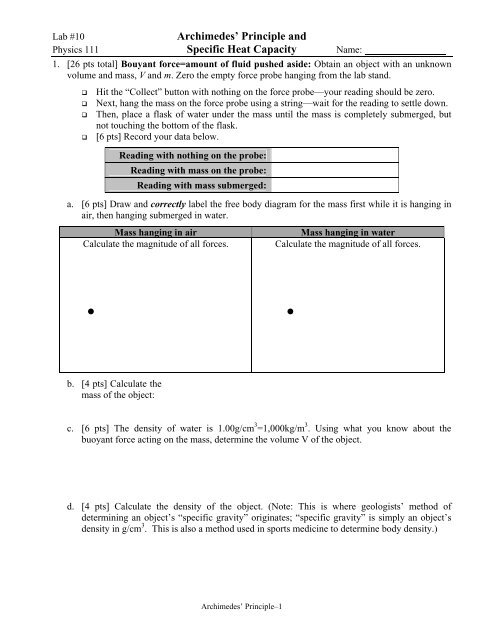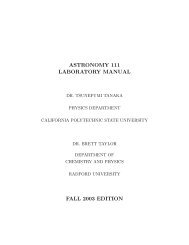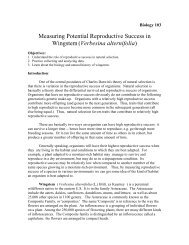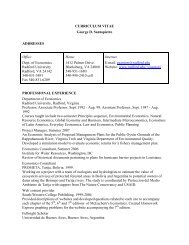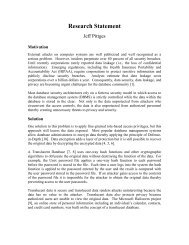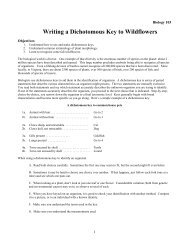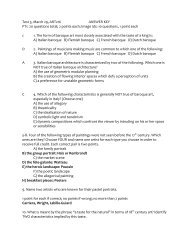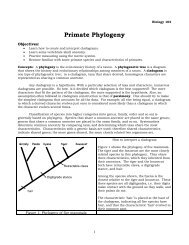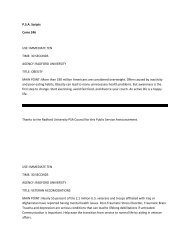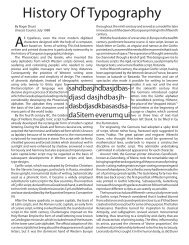You also want an ePaper? Increase the reach of your titles
YUMPU automatically turns print PDFs into web optimized ePapers that Google loves.
Lab #<strong>10</strong><br />
Archimedes’ Principle and<br />
Physics 111 Specific Heat Capacity Name:<br />
1. [26 pts total] Bouyant force=amount of fluid pushed aside: Obtain an object with an unknown<br />
volume and mass, V and m. Zero the empty force probe hanging from the <strong>lab</strong> stand.<br />
<br />
<br />
<br />
<br />
Hit the “Collect” button with nothing on the force probe—your reading should be zero.<br />
Next, hang the mass on the force probe using a string—wait for the reading to settle down.<br />
Then, place a flask of water under the mass until the mass is completely submerged, but<br />
not touching the bottom of the flask.<br />
[6 pts] Record your data below.<br />
Reading with nothing on the probe:<br />
Reading with mass on the probe:<br />
Reading with mass submerged:<br />
a. [6 pts] Draw and correctly <strong>lab</strong>el the free body diagram for the mass first while it is hanging in<br />
air, then hanging submerged in water.<br />
Mass hanging in air<br />
Calculate the magnitude of all forces.<br />
Mass hanging in water<br />
Calculate the magnitude of all forces.<br />
b. [4 pts] Calculate the<br />
mass of the object:<br />
c. [6 pts] The density of water is 1.00g/cm 3 =1,000kg/m 3 . Using what you know about the<br />
buoyant force acting on the mass, determine the volume V of the object.<br />
d. [4 pts] Calculate the density of the object. (Note: This is where geologists’ method of<br />
determining an object’s “specific gravity” originates; “specific gravity” is simply an object’s<br />
density in g/cm 3 . This is also a method used in sports medicine to determine body density.)<br />
Archimedes’ Principle–1
Lab #<strong>10</strong><br />
Archimedes’ Principle and<br />
Physics 111 Specific Heat Capacity Name:<br />
2. [32 pts total] Specific heat capacity ‘c’: Q=mcΔT. In this part of the <strong>lab</strong>, you will put a heated<br />
unknown material in a water-filled container and measure its heat capacity.<br />
[6 pts] Initial Data (before adding hot unknown)<br />
Mass of empty aluminum container<br />
Mass of container filled ¾ full with water<br />
Initial temperature of water and container<br />
Take your unknown from the hot water and quickly place it in your container.<br />
[6 pts] Final Data (after adding hot unknown)<br />
Temperature of hot unknown in boiling water<br />
Final temperature of water, container and unknown<br />
(after placing unknown in water and T has stabilized)<br />
Mass of unknown (after removal from container)<br />
A. Calculate the following, showing your work clearly.<br />
a. [4 pts] Find the magnitude of the heat energy gained by your water.<br />
b. [4 pts] Find the magnitude of the heat energy gained by the inner aluminum container.<br />
c. [4 pts] Calculate the magnitude of the heat energy lost by the unknown.<br />
d. d[4 pts] Calculate the specific heat of the unknown material.<br />
e. [4 pts] Identify your material from a table of specific heats. And no, appearance (color) alone<br />
isn’t sufficient. Check your numbers with a staff member.<br />
Archimedes’ Principle and Specific Heat Capacity–2


